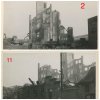My thoughts so far are that the trolley bus overhead lines and tram tracks could narrow the search for some streets but so far I have not found them.
Image 5 has a fairly high quality building with a trolleybus overhead line in the pic. Trolleybus overhead cables were close together with a live wire and neutral return. Trams could use the steel tracks for the neutral return. Trams could however use the live wire on trolleybus overhead lines. There is a hint of a tram track in image 5. The sign showing a possible name appears to have been covered over with a pen on the original photo.
Image 6 is the same building as shown in image 5.
Image 8 shows tram tracks in the street and tram overhead lines can be seen. The pillars of the building have white horizontal sections which might identify the building in a forum street pic somewhere.
Image 9 shows overhead trolleybus or tram lines.
Image 10 shows trolleybus overhead lines and tram tracks.
Image 11 is the corner of New Street and Bennetts Hill. The Shoothill site has the image on twice and one image is identified.
The trolleybus shown in
post#20 appears to be turning from Corporation St into Lower Priory and in other street pics on the forum there appears to be some bomb damage at bottom of Lower Priory although there were no high quality buildings down there.
Two identified bomb damage images below from Shoothill show typical trolleybus overhead lines and poles.
Moor Street - see the close together overhead lines.

Gooch Street near the River Rea shows a damaged trolleybus pole.
















